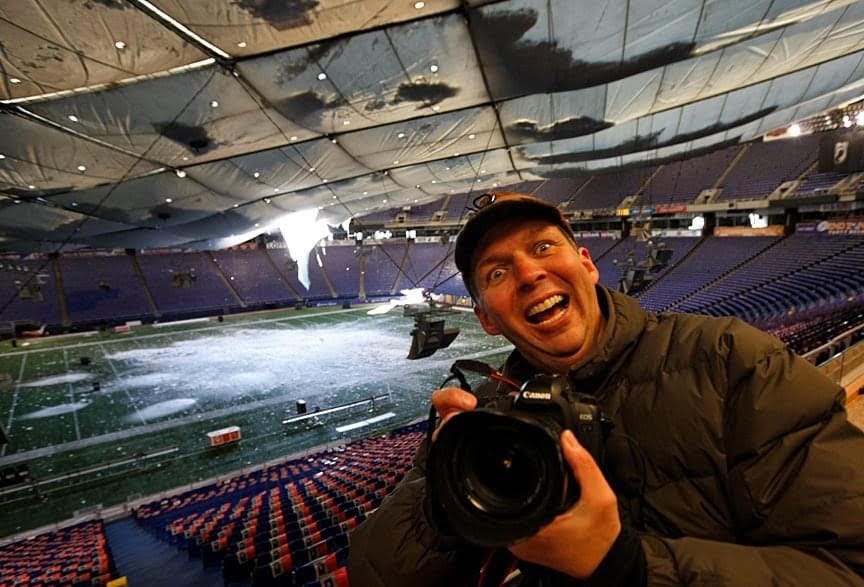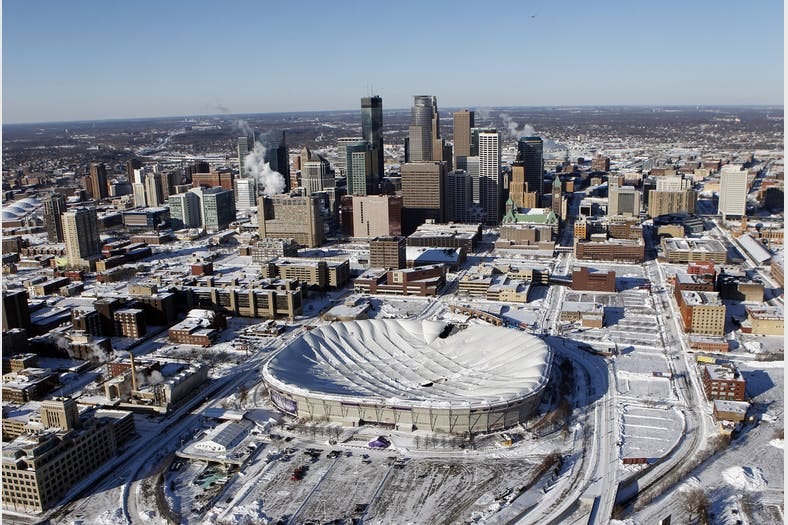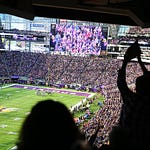
Click the player above to listen to this special Purple Insider bonus feature on two photojournalists who chronicled the Metrodome collapse.
On December 12, 2010, the Metrodome roof collapsed.
It's one of the most iconic scenes in Minnesota Sports history -- one, because something that crazy would only ever happen in Minnesota -- but also because it marked the end of so many incredible sports moments, from the Twins two world series' to Randy Moss's emergence as one of the greatest NFL players to ever set foot on turf to Brett Favre joining the Vikings and on and on
When you think of the collapse, you see the image. You see the inside with the pile of snow in the middle and the tattered roof. You see the sun peering through in a post-apocalyptic kind of way.
You also see in your mind's eye the overhead view. Like someone let the air out of a giant balloon. Or like there's a crater in the earth where all the sports used to be.
The most iconic images of the dome collapse were taken by two Star Tribune photographers, Carlos Gonzalez and Brian Peterson.
Gonzalez was overhead while Peterson was inside the stadium. Let's just say that Carlos got the tougher of the two assignments.
“I think I remember getting a call in the morning that the roof had collapsed and I knew there had been some snow storms so I’m thinking, ‘oh wow,’ and something similar happened years ago but I guess I didn’t realize it was a possibility,” Gonzalez said.
“So my responsibility was to go up in a chopper and get aerial views of it and I remember it was a really cold day right around subzero or slightly above so I go to the airport and there’s a chopper waiting for us and on that day we’re flying in a Robinson R22, which is a really small helicopter and when we do aerial photos we take a door off because you don’t want to shoot through dirty glass and sure enough we had a door off and I remember walking up and asking the pilot, ‘Hey, when is it too cold to fly one of these things?’ He said they stop doing training when it’s under 10 or five and it was like two degrees. I remember before getting into the flight thinking, ‘OK this is a good idea.’”
Carlos had no idea what he was going to see once he got into the helicopter. Once he got up there, he tried to give the world an idea of what the broken dome looked like relative to the city.
“I didn’t know what I was going into, I didn’t know what it was going to look like or how bad it had caved in at that point so when you get there, it’s like ‘Oh wow,’” Gonzalez said. “I wanted to shoot the details as close as I could and also backed off and put it in a setting of showing, here’s the Metrodome and here’s Minneapolis and to give you an idea of where it’s at relative to downtown for people who don’t know Minneapolis and try to show that.”
Inside the dome -- Brian felt something he'd never felt when working in the building: Freezing cold. He and other photographers took pictures of each other as the icy air from outside poured in.
“I think only a limited number of photographers were allowed in because they were afraid of it collapsing further and we were escorted in and escorted to the football press box which was the only position we could actually shoot from but it gave us a good vantage point to the whole thing,” Peterson said. “It was really bizarre going in there and having the ceiling sagging down behind your head position from the press box. It was a bizarre scene and very quiet, eerily quiet and dark. None of the lights were on. It was a really strange thing to go there and see it.”
“If you’ve been in the Metrodome you know what the concourse is like,” Peterson said. “You get these glimpses through these concrete entry ways into the seating area. They were kind of shuffling us through the concourse and every time you went by an opening you could peak in. The one thing I do remember is that it was freezing cold in there because the heat was off and it was freezing cold, which I had never experienced that in the Metrodome. That’s what we loved about it, it was always 70 degrees in there. Then when they brought us into the press box we were about midfield and you could see the pile of snow in the middle of the field. It was a strange feeling.”

Sometimes when covering a sporting event, you understand the magnitude as its happening. Brian talked about shooting the Super Bowl and the Twins's world series appearances over his many years in the business and other times you don't realize how significant was until it's over. With the dome collapse, both Brian and Carlos felt right away that it would be one of the most memorable days in Minnesota sports history.
“I always think of history in terms of what I’m photographing even though I work for a daily newspaper and things get cranked in and out and you don’t always think of history but I’ve always been aware of historic major events like that and what impact they can have on the community and certainly the importance of capturing it to the best of your ability,” Peterson said. “Letting people feel what it felt like to be in there. A lot of us were taking pictures of each other in there with that in the background — more for social media purposes than anything else — but we’re always trying to get the human element in there too. When I was in the press box I remember shooting quite a few pictures with other photographers shooting pictures rather than just shooting the empty stadium.”
“It was pretty trippy to think, ‘Wow, the roof of this thing is gone’ and what are the implications and all that kind of thing,” Gonzalez said. “You don’t really think about it at the time but as the days went on, it got a lot more traction.
Having covered so many events inside the Metrodome, the photographers reflected on some of their best moments inside ....but Brian also pointed out that it wouldn't be missed by those who were chronicling games and events inside
“It was stinky, we had photo positions down on the field right by the sewer pipes and we had mice and all kinds of fun stuff down there,” Peterson said. “Almost every photographer had a universal hatred for the Metrodome. The morning that we heard it collapsed it was kind of a bitter sweet thing. We knew the dome was coming to an end but to actually see the roof collapse and see all that snow on the field, it was kind of a fitting end.”
Carlos and Brian look at the photographs of the metrodome collapse as a point about the importance of photojournalism. Nobody's snapping Carlos's iconic picture from the helicopter on an iPhone. Nobody's getting the full breadth of the damage inside that way either.
“I think that commitment really shows in our product,” Gonzalez said. “If you look at the paper and the things we’re doing on a daily basis, from news to sports to features and everything in between, it really shows. I think they realize that and understand the importance of that. Not only the service we provide to the community but I think readers appreciate that. This big event happened and there was no hesitation. I got a call and I’m going up in a chopper. It was automatic. Now looking back it seems like a no-brainer, why wouldn’t you do that? But other papers didn’t do that. Things like that shows you how we understand our place in the community and what we need to do to cover it.”
With the dome down, the Vikings eventually moved into US Bank Stadium and the mice moved elsewhere and the photographers were given much better lighting and less unfortunate placement... but the Dome will always live as the place of all sorts of crazy Minnesota sports events, including its own collapse.
Where does it rank in terms of weirdest Minnesota things that Gonzalez has covered?
“Probably top 10,” he said.
That really says something about Minnesota sports, doesn’t it?
Check out our sponsor SotaStick and their Minnesota-inspired gear by clicking the logo. Use the code PurpleInsider for free shipping






Bonus feature: The story behind the Metrodome roof collapse photos